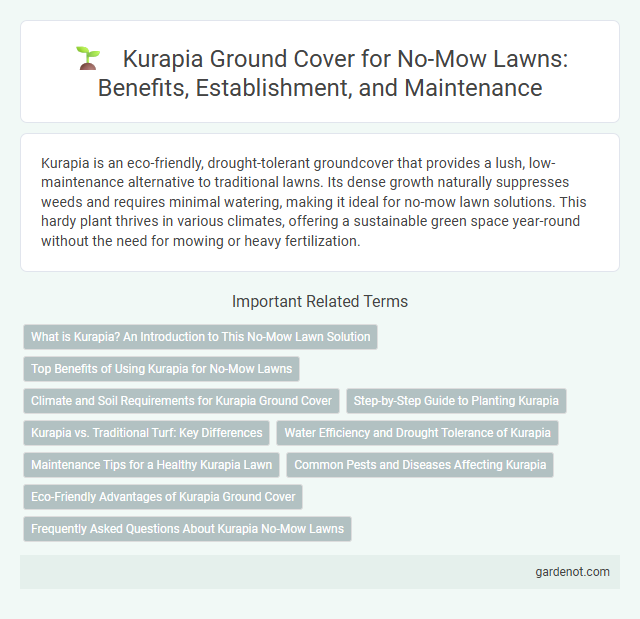Kurapia is an eco-friendly, drought-tolerant groundcover that provides a lush, low-maintenance alternative to traditional lawns. Its dense growth naturally suppresses weeds and requires minimal watering, making it ideal for no-mow lawn solutions. This hardy plant thrives in various climates, offering a sustainable green space year-round without the need for mowing or heavy fertilization.
What is Kurapia? An Introduction to This No-Mow Lawn Solution
Kurapia is a low-maintenance, drought-tolerant ground cover that serves as an eco-friendly alternative to traditional grass lawns, flourishing with minimal watering and no mowing required. This resilient plant, scientifically known as Lippia nodiflora, forms a dense, green carpet that suppresses weeds and attracts pollinators, making it ideal for sustainable landscaping. Its rapid growth and ability to thrive in various soil types make Kurapia a practical solution for homeowners seeking attractive, water-saving yard options.
Top Benefits of Using Kurapia for No-Mow Lawns
Kurapia offers exceptional drought tolerance and rapid ground coverage, reducing water consumption by up to 70% compared to traditional grass lawns. This low-maintenance ground cover suppresses weeds naturally, eliminating the need for chemical herbicides and reducing lawn care costs. Its deep root system enhances soil stability while creating a lush, green appearance without mowing or fertilizing.
Climate and Soil Requirements for Kurapia Ground Cover
Kurapia ground cover thrives in USDA hardiness zones 5 through 9, adapting well to both temperate and subtropical climates. It prefers well-drained, sandy to loamy soils with a slightly acidic to neutral pH range of 5.5 to 7.5. Kurapia exhibits drought tolerance once established, making it ideal for no-mow lawns in regions with moderate rainfall and occasional dry spells.
Step-by-Step Guide to Planting Kurapia
Kurapia, a low-maintenance ground cover ideal for no-mow lawns, thrives best when planted during spring or early summer in well-drained soil with full sun exposure. Start by preparing the soil through loosening and removing weeds, then spread Kurapia seeds or seedlings evenly across the area, lightly covering them with soil or mulch to retain moisture. Water consistently to keep the soil moist until roots establish, typically within 4 to 6 weeks, ensuring a dense, drought-resistant lawn alternative.
Kurapia vs. Traditional Turf: Key Differences
Kurapia is a drought-resistant ground cover that requires minimal mowing compared to traditional turf grasses, significantly reducing maintenance time and water usage. Unlike conventional lawns, Kurapia offers dense, low-growing foliage that suppresses weeds naturally and thrives in poor soils with high heat tolerance. This sustainable alternative enhances lawn durability while promoting eco-friendly, water-efficient landscaping.
Water Efficiency and Drought Tolerance of Kurapia
Kurapia exhibits exceptional water efficiency, requiring up to 80% less irrigation compared to traditional turf grasses, making it ideal for water-scarce regions. Its deep root system enhances drought tolerance by maintaining soil moisture and reducing evaporation during extended dry periods. This hardy ground cover thrives with minimal watering, significantly lowering landscape water consumption while maintaining a lush, green appearance.
Maintenance Tips for a Healthy Kurapia Lawn
Kurapia thrives with minimal mowing, requiring cutting only once or twice a year to maintain its dense, ground-covering growth. Regular watering during prolonged dry spells supports its drought tolerance while occasional fertilization with a balanced, slow-release formula promotes vibrant, healthy foliage. Efficient weed control through manual removal or targeted herbicides prevents competition, ensuring a lush, no-mow lawn year-round.
Common Pests and Diseases Affecting Kurapia
Kurapia is highly resistant to common lawn pests such as grubs, chinch bugs, and armyworms, reducing the need for chemical treatments. However, it can occasionally be affected by fungal diseases like powdery mildew and leaf spot, especially in humid or poorly drained conditions. Proper lawn maintenance, including adequate spacing and airflow, helps minimize these disease risks and maintains Kurapia's vibrant, no-mow appeal.
Eco-Friendly Advantages of Kurapia Ground Cover
Kurapia ground cover offers an eco-friendly alternative to traditional lawns by significantly reducing water consumption, using up to 75% less water than conventional grass. Its dense, drought-tolerant growth inhibits weed proliferation, minimizing the need for chemical herbicides and fertilizers. Kurapia's ability to thrive without mowing decreases carbon emissions, making it a sustainable choice for environmentally conscious landscaping.
Frequently Asked Questions About Kurapia No-Mow Lawns
Kurapia is a low-maintenance ground cover ideal for no-mow lawns, thriving in full sun and well-drained soil. It requires minimal watering once established, resists weed growth, and stays green year-round, making it a sustainable turf alternative. Common questions address its drought tolerance, establishment time, and compatibility with foot traffic, all of which confirm Kurapia's suitability for eco-friendly landscaping.
Kurapia Infographic

 gardenot.com
gardenot.com